In addition to these paid promotions, GM produced a complete tent
show of their own on two occasions, the first being in 1936, which was
organized in Detroit and moved south to Florida in a close caravan.
Giving the caravan a send-off were none other than Alfred P. Sloan and
Charles "Boss Ket" Kettering. No performances were given in
Detroit or any of the cities en route to Florida. The plan was to get
maximum publicity from the caravan itself by having it move south,
visiting GM assembly plants and some of the larger dealers along the
way. The fleet of unusual trucks were displayed at each site for view
by employees, the public, and, of course, the press. However, the
tents and midway would not be set until they reached Florida.
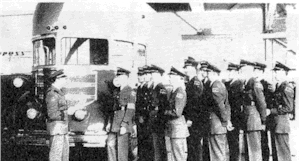 GM wanted attention even when the show passed on the highway, so
all movement was handled as a military convoy. A Cadillac command car
was in the lead and communicated with some of the trucks back in the
pack by short wave radio. An assortment of automobile models from all
GM divisions were included in the convoy. Drivers always wore uniforms
on the road, when visiting GM plants or when performing, although
white coveralls were provided for workdays when the exhibit was being
erected.
GM wanted attention even when the show passed on the highway, so
all movement was handled as a military convoy. A Cadillac command car
was in the lead and communicated with some of the trucks back in the
pack by short wave radio. An assortment of automobile models from all
GM divisions were included in the convoy. Drivers always wore uniforms
on the road, when visiting GM plants or when performing, although
white coveralls were provided for workdays when the exhibit was being
erected.
 Travel was slow, partly because GM wanted everyone the convoy
passed to get a good look and partly because the streamlined trucks
were seriously underpowered by today’s standards. GM’s small truck
engines were based on the flat head Oldsmobile block and offered
displacements of only 230-257 cid. The trucks had a 4-speed
transmission with a very low first gear that the drivers called
"creeper." This was needed on many hills. Because the vacuum
power brakes were not as effective as might have been desired,
downshifting was the rule on most hills. In addition to the eight
streamliners, the fleet included conventional GM trucks, including
semis, that carried the big top, chairs, an electric light plant and
mechanics’ supplies.
Travel was slow, partly because GM wanted everyone the convoy
passed to get a good look and partly because the streamlined trucks
were seriously underpowered by today’s standards. GM’s small truck
engines were based on the flat head Oldsmobile block and offered
displacements of only 230-257 cid. The trucks had a 4-speed
transmission with a very low first gear that the drivers called
"creeper." This was needed on many hills. Because the vacuum
power brakes were not as effective as might have been desired,
downshifting was the rule on most hills. In addition to the eight
streamliners, the fleet included conventional GM trucks, including
semis, that carried the big top, chairs, an electric light plant and
mechanics’ supplies.
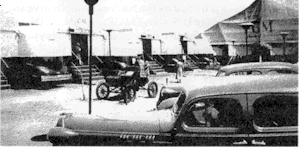 Moves were always made in daytime for publicity, so personnel were
boarded in hotels and ate in restaurants. Life in this
"circus" was easier than in most traveling shows. Drivers
were paid $100 a month; uniforms, coveralls, and hotel rooms were
provided; and the food allowance was $18.50 a week, which, in 1936,
allowed them to dine well. Like the traditional circus, the Parade of
Progress had an advance agent who traveled ahead booking lots, parking
space, hotels, and other needs.
Moves were always made in daytime for publicity, so personnel were
boarded in hotels and ate in restaurants. Life in this
"circus" was easier than in most traveling shows. Drivers
were paid $100 a month; uniforms, coveralls, and hotel rooms were
provided; and the food allowance was $18.50 a week, which, in 1936,
allowed them to dine well. Like the traditional circus, the Parade of
Progress had an advance agent who traveled ahead booking lots, parking
space, hotels, and other needs.
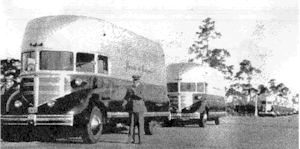 After the caravan arrived in Lakeland, FL, the tents and midway
were set up for the first time and the full performance was rehearsed.
The big top was a two-pole tent with the stage in the middle of one
long side. Seats were opposite the state and in both ends. One of the
streamliners unfolded to form the stage, and another was behind the
center section of seats, containing an enclosed movie projection booth
for films that were part of the program. Performances consisted of
juggling, magic, and scientific demonstrations tied in with product
displays. This may have been the first time that microwave cooking was
demonstrated – emcee Erie Foss cooked an egg on a handkerchief with
no protection from the radiation.
After the caravan arrived in Lakeland, FL, the tents and midway
were set up for the first time and the full performance was rehearsed.
The big top was a two-pole tent with the stage in the middle of one
long side. Seats were opposite the state and in both ends. One of the
streamliners unfolded to form the stage, and another was behind the
center section of seats, containing an enclosed movie projection booth
for films that were part of the program. Performances consisted of
juggling, magic, and scientific demonstrations tied in with product
displays. This may have been the first time that microwave cooking was
demonstrated – emcee Erie Foss cooked an egg on a handkerchief with
no protection from the radiation.
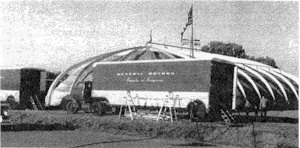 While the canvas boss and his workmen set up the tent and seats,
the drivers set up the exhibits. The truck fleet included eight
streamliners, three of which were used for a walk-through midway
display. They were parked in a parallel arrangement several feed
apart. The sides split apart horizontally so that the upper halves
joined to form a roof and the lower halves formed a floor. Side panels
carried in the truck enclosed the space, and the tree trucks thus
connected formed a continuous hall filled with exhibits. Patrons
entered the front truck and exited the rear truck. The show opened in
St. Petersburg, FL, followed by Tampa, Miami, and then went up the
East Coast, hitting most of the major cities along the way.
While the canvas boss and his workmen set up the tent and seats,
the drivers set up the exhibits. The truck fleet included eight
streamliners, three of which were used for a walk-through midway
display. They were parked in a parallel arrangement several feed
apart. The sides split apart horizontally so that the upper halves
joined to form a roof and the lower halves formed a floor. Side panels
carried in the truck enclosed the space, and the tree trucks thus
connected formed a continuous hall filled with exhibits. Patrons
entered the front truck and exited the rear truck. The show opened in
St. Petersburg, FL, followed by Tampa, Miami, and then went up the
East Coast, hitting most of the major cities along the way.
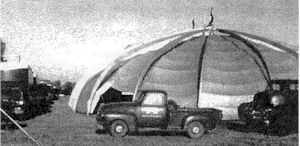 After the tour ended the equipment was stored and eventually sold,
including the streamliners. Several of these easily recognized trucks
have turned up in other service. The streamliner that formed the stage
is shown being used for a USO Motor Camp Show performance in 1941 in
the book, U.S. Military Wheeled Vehicles, where author F. W. Crismon
lists it in the 5-ton category.
After the tour ended the equipment was stored and eventually sold,
including the streamliners. Several of these easily recognized trucks
have turned up in other service. The streamliner that formed the stage
is shown being used for a USO Motor Camp Show performance in 1941 in
the book, U.S. Military Wheeled Vehicles, where author F. W. Crismon
lists it in the 5-ton category.
The 1954 Parade of Progress was organized on the same patter as the
1936 show, but was different in several ways. An entirely new fleet of
GM trucks were used, consisting of current conventional models for the
heavy loads and a new concept in streamliners for exhibits. These were
evidently influenced by popular military aircraft designs and featured
bubble glass cockpits for the drivers in place of conventional two-man
cabs. Also, the big top was an innovative design using an exterior
aluminum frame to support the canvas, and since there were no poles
the interior was unobstructed.